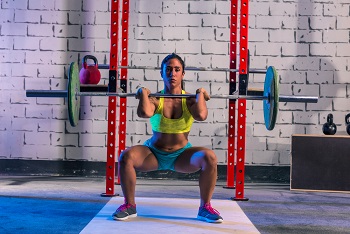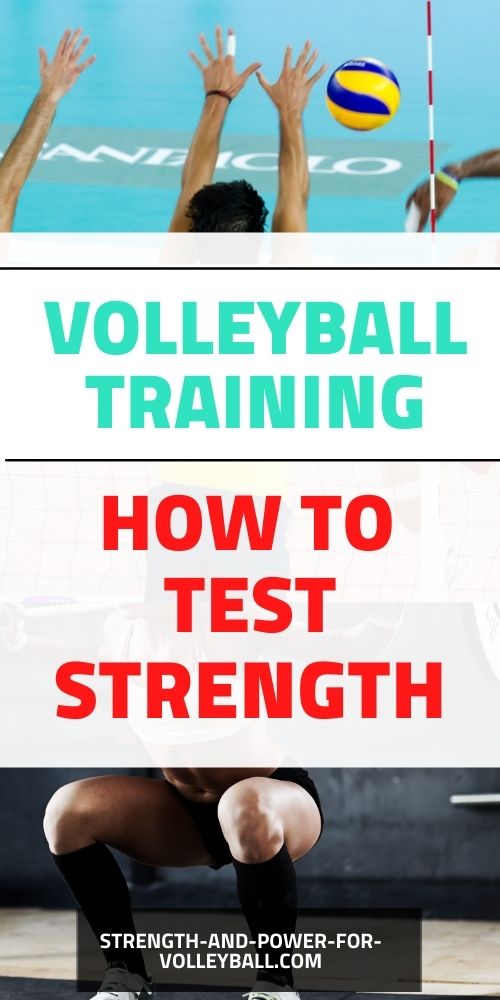- Home
- Conditioning
- volleyball training
Volleyball Training
Tests for Strength, Speed, Power, & Agility
Testing athletes is important to the design of volleyball training programs.
Why test? Testing helps athletes and coaches assess athletic talent and identify physical abilities and areas in need of improvement.
Assessment is most often thought of as the portion of the training program that occurs after an athlete has been trained. But if you want to know where you're going, you first need to determine where you're coming from.
Assessment before and during a volleyball training program allows for testing of various athletic abilities to determine strengths and weaknesses.
Testing the Barbell Back Squat
Many movements in sports tend to be repetitive. Constant repetition can cause incorrect muscular movement patterns. These athletic weaknesses will more than likely influence your tests results.
Understanding common movement patterns is helpful in determining appropriate assessment tests for your volleyball training.
Types of Assessment Tests
Maximum Muscular Strength Tests. If you have fine tuned your technique for an exercise (generally about 300 sets) and developed a solid strength base, you can perform max strength tests to determine the best workout for volleyball program. Maximum muscular strength tests involve determining an athletes 1RM. 1RM (1 Rep Max) reflects the kind of dynamic ability necessary for sports and are the most popular tests for measuring maximum muscular strength.
Maximum Muscular Power Tests. Anaerobic muscular power tests are strength and power tests that are very short in duration, produce high power, and are performed using fast movements. Explosive exercises, vertical jump tests, or short sprints are all common methods for testing muscular power.
Anaerobic Capacity Tests. Anaerobic Capacity is the maximal rate of energy production by the combined phosphagen and lactic acid energy systems for moderate-duration activities (1). Anaerobic capacity tests typically consist of performing an exercise for 30 to 90 seconds at maximum effort.
Local Muscular Endurance Tests. A test for local muscular endurance is performing an exercise continuously for several seconds to several minutes without the advantage of rest periods. Possible local muscular endurance tests are performing maximal number of repetitions in the chin-up or push-up exercise. Also, performing a resistance training exercise using a fixed load is another common method of testing.
Aerobic Capacity Tests. Aerobic capacity is the maximum volume of oxygen that can be used for energy by an athlete's muscles during exercise. Aerobic Capacity is generally measured by performing aerobic endurance activities such as running distance.
Agility Tests. The agility T-Test generally reflect the ability to explosively brake, change direction, and quickly accelerate again.
Speed tests. Speed tests are typically performed by doing sprints at an all out effort to achieve maximum velocity. Sprints should cover a distance less than 200 meters because longer distances will more likely reflect anaerobic or aerobic capacity than the ability to achieve maximum speed.
| Basic Athletic Assessment Tests | |||
|---|---|---|---|
| Type | Tests | ||
| Maximum Muscular Strength | 1RM Bench Press, 1RM Back Squat | ||
| Maximum Muscular Power | 1RM Power Clean, Vertical Jump | ||
| Anaerobic Capacity | 300 Yard Shuttle, Line Drill | ||
| Local Muscular Endurance | Sit Up Test, Push Up Test | ||
| Aerobic Capacity | 1.5 Mile Run | ||
| Agility | T-Test, Hexagon Test | ||
| Speed | 40 Yard Sprint | ||
| Flexibility | Sit and Reach Test | ||
Setting goals and using baseline scores. Test scores can be used in setting goals. Testing to determine a baseline is useful for setting initial goals.
Testing at regular periods throughout a volleyball training cycle can help track an athlete's progress in reaching those goals.
Using tests with setting goals allows coaches to set specific goals with individual athletes.
Also, goals may be used to inspire athletes to accomplish group or team objectives.
Identifying Talent. Duties of a volleyball coach may include determining if an athlete's basic physical ability in combination with skill development and volleyball training will produce a competitive player.
For example, if a coach is having a tryout for their volleyball team, they may need to determine whether an athlete has the physical potential to play competitively for their team.
Identifying Overtraining. Field tests are also used to identify burnout and overtrained athletes. When inappropriate volleyball workout programs are repeated over time, overtraining is common.
Have a reason for testing. In most sports, tests should be performed depending on the time of year and where an athlete is in their volleyball training cycle.
For example, it wouldn't make sense to test volleyball players in a 1.5 mile run at the beginning of their volleyball season.
If an athlete's volleyball training has consisted mainly of developing anaerobic power to prepare for their up coming season, testing aerobic capacity wouldn't be a valid test to perform.
Test Order. Assessment tests should never be conducted at the end of a strenuous workout or after competition.
Tests need to be arranged in appropriate order with sufficient rest between tests to promote test reliability.
Tests that require high movement skill and coordination should not be done immediately after tests that are likely to produce fatigue.
When testing for Aerobic Capacity, it may be better to test on a separate day. If you do test for Aerobic Capacity on the same day, make sure there is at least 1 hour of rest before testing for complete energy system recovery.
Typically, tests should be administered in the following order.
- Non-Fatiguing Tests
- Agility Tests
- Maximum Power and Strength Tests
- Sprint Tests
- Local Muscular Endurance Tests
- Fatiguing Anaerobic Capacity Tests
- Aerobic Capacity Tests
Injury Prevention. Injury is an important consideration during assessment. Coaches need to remember that assessment tests can be very physically demanding for an athlete.
Coaches need to be cautious if an athlete isn't physically ready for testing or if they are still recovering from a previous injury. Not only could the athlete's performance on the test be less valuable, but they may aggravate the injury.
Judging the Effectiveness of a Conditioning Program. The effectiveness of a volleyball training program shouldn't necessarily be judged by the degree of improvement.
Athletes that begin the training period at a higher training status will not improve as much as untrained athletes who perform poorly at the beginning of training. For example, an athlete that starts a weight training for volleyball program for the first time will see great results quicker than an athlete that starts the program with 2 years of previous weight training experience. This is a major reason why the pre-training status of an athlete must be considered when evaluating the success of a volleyball training program.
Also, athletes may deliberately fail to give maximal effort on pre-training tests to inflate their test scores. Therefore, it is important to encourage athletes to give maximal effort on both pre and post assessment tests.
References
1) Baechle, T.B. & Earle, R.E. (2000). Essentials of strength and conditioning. Human Kinetics, Champaign. IL.
Volleyball Training Related Pages
Sport Specific Conditioning for Volleyball
Volleyball Conditioning the Right Way
Static Volleyball Flexibility
